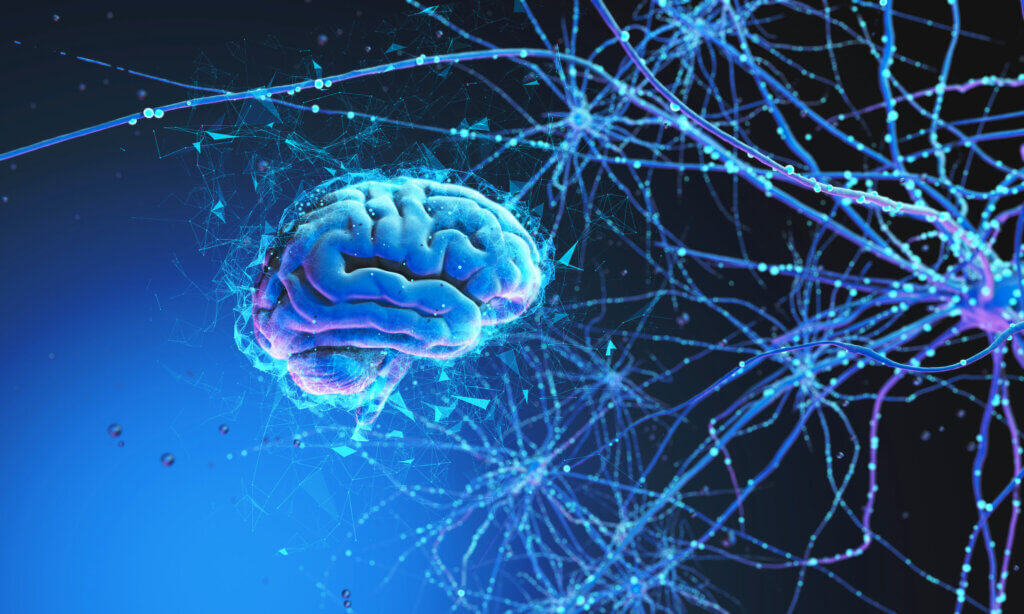Aphantasia: The Inability to Imagine

Creating visual images in our minds allows us to project objects and experiences in their absence. In addition, it’s useful for rehearsing situations that we can then apply in reality. But what happens when there’s an inability to recreate moments of this type? Aphantasia is precisely this, and it’s more common than people realize.
Francis Galton was the first to describe the phenomenon in 1880, although since then it hasn’t received too much interest among scientists and is poorly understood. Galton compared it to color blindness, in the sense that those who suffer from it can only have an idea of the true color (mental experience, in this case) based on descriptions. Let’s see what’s known about aphantasia and its characteristics.
Characteristics of aphantasia
Experts define aphantasia as the ‘inability to visualize mental images’. Sufferers are characterized by an absence of voluntarily generated internal visual representations. The phenomenon varies from person to person in terms of intensity, so the actual impact on daily life is highly variable.
A study published in Consciousness and Cognition in 2022 suggests that the prevalence of phantasy in the general population is around 4%. This is in contrast to hyperphantasia, which is the generation of very vivid mental images. Zeman et al. coined the term in 2015 to refer to the reduced or completely absent ability of some people to create mental images.
Those who develop the phenomenon can’t carry out activities that require recreating mental scenarios in order to make any sense. For example, reading books, exercising autobiographical memory, starting facial recognition, or thinking about people close to you.
It’s important to emphasize that the inability to recreate mental images is not due to a lack of effort, but implies a real lack of ability to do so.
Causes of aphantasia

The phenomenon has not been studied enough, so there are gaps regarding the exact mechanisms behind it. Initially, Zeman and his team described, in 2010, a case of a subject who had lost the ability to generate mental images after minor surgery.
Evidence suggests that aphantasia is associated with scientific and mathematical occupations, while hyperphantasia is associated with creative professions. Similarly, it’s more common among family members, which would indicate a possible genetic predisposition.
It has been suggested that aphantasics and non-aphantasics (those who do and don’t suffer from this condition) differ in the connectivity between various prefrontal regions and the occipital visual network of the brain.
Cases of aphantasia have been reported after autologous stem cell transplantation. The phenomenon has not been related to metacognition problems, so, up to now, its causes don’t lie in problems of this type.
In addition to all this, the presence of mental disorders or traumatic episodes can be a catalyst for their appearance. Its triggers aren’t well understood, and studies in the coming decades should shed more light on it.
Consequences and impact on the well-being of those affected

We have mentioned that the impact on the day-to-day lives of people with aphantasia is highly variable. The strategies developed to deal with the phenomenon, the work of the affected person, their social environment, the intensity of the condition, and other factors all affect its real impact. Even so, we leave you with some typical consequences of aphantasia:
- The reduced ability to perform tasks that require viewing images.
- Changes in the ability to remember sounds, songs, phrases, and so on (although it isn’t directly related to aphantasia, the ability is affected somewhat).
- Problems recalling episodic events from the past. They range from dim memories to the complete inability to do so.
- Inability or problems to do future prospecting exercises (plan activities for the next day, for example).
- Disadvantages in performing mental exercises.
- Reduction of dream experiences during night rest. These are also less vivid in contrast to non-aphantasic people.
- Reduced spatial visualization ability. Although it’s mild, it can affect spatial navigation.
Many people are unaware that they have aphantasia, just as many are unaware that they’re color blind. Most of the time it’s a congenital phenomenon, although, as we have seen, it can also be acquired. In principle, it shouldn’t represent a major problem in daily life, as its consequences can be cushioned in one way or another.
Several people who engage in creative work have claimed to have some degree of aphantasia. For example, Ed Catmull, Richard Herring, Zelda Williams, Blake Ross, Mark Lawrence, and many others. All of these have developed strategies to overcome their limitations.
The scientific interest is relatively recent, so that, as the years go by, its nature and the mechanisms behind it should be better understood.
Creating visual images in our minds allows us to project objects and experiences in their absence. In addition, it’s useful for rehearsing situations that we can then apply in reality. But what happens when there’s an inability to recreate moments of this type? Aphantasia is precisely this, and it’s more common than people realize.
Francis Galton was the first to describe the phenomenon in 1880, although since then it hasn’t received too much interest among scientists and is poorly understood. Galton compared it to color blindness, in the sense that those who suffer from it can only have an idea of the true color (mental experience, in this case) based on descriptions. Let’s see what’s known about aphantasia and its characteristics.
Characteristics of aphantasia
Experts define aphantasia as the ‘inability to visualize mental images’. Sufferers are characterized by an absence of voluntarily generated internal visual representations. The phenomenon varies from person to person in terms of intensity, so the actual impact on daily life is highly variable.
A study published in Consciousness and Cognition in 2022 suggests that the prevalence of phantasy in the general population is around 4%. This is in contrast to hyperphantasia, which is the generation of very vivid mental images. Zeman et al. coined the term in 2015 to refer to the reduced or completely absent ability of some people to create mental images.
Those who develop the phenomenon can’t carry out activities that require recreating mental scenarios in order to make any sense. For example, reading books, exercising autobiographical memory, starting facial recognition, or thinking about people close to you.
It’s important to emphasize that the inability to recreate mental images is not due to a lack of effort, but implies a real lack of ability to do so.
Causes of aphantasia

The phenomenon has not been studied enough, so there are gaps regarding the exact mechanisms behind it. Initially, Zeman and his team described, in 2010, a case of a subject who had lost the ability to generate mental images after minor surgery.
Evidence suggests that aphantasia is associated with scientific and mathematical occupations, while hyperphantasia is associated with creative professions. Similarly, it’s more common among family members, which would indicate a possible genetic predisposition.
It has been suggested that aphantasics and non-aphantasics (those who do and don’t suffer from this condition) differ in the connectivity between various prefrontal regions and the occipital visual network of the brain.
Cases of aphantasia have been reported after autologous stem cell transplantation. The phenomenon has not been related to metacognition problems, so, up to now, its causes don’t lie in problems of this type.
In addition to all this, the presence of mental disorders or traumatic episodes can be a catalyst for their appearance. Its triggers aren’t well understood, and studies in the coming decades should shed more light on it.
Consequences and impact on the well-being of those affected

We have mentioned that the impact on the day-to-day lives of people with aphantasia is highly variable. The strategies developed to deal with the phenomenon, the work of the affected person, their social environment, the intensity of the condition, and other factors all affect its real impact. Even so, we leave you with some typical consequences of aphantasia:
- The reduced ability to perform tasks that require viewing images.
- Changes in the ability to remember sounds, songs, phrases, and so on (although it isn’t directly related to aphantasia, the ability is affected somewhat).
- Problems recalling episodic events from the past. They range from dim memories to the complete inability to do so.
- Inability or problems to do future prospecting exercises (plan activities for the next day, for example).
- Disadvantages in performing mental exercises.
- Reduction of dream experiences during night rest. These are also less vivid in contrast to non-aphantasic people.
- Reduced spatial visualization ability. Although it’s mild, it can affect spatial navigation.
Many people are unaware that they have aphantasia, just as many are unaware that they’re color blind. Most of the time it’s a congenital phenomenon, although, as we have seen, it can also be acquired. In principle, it shouldn’t represent a major problem in daily life, as its consequences can be cushioned in one way or another.
Several people who engage in creative work have claimed to have some degree of aphantasia. For example, Ed Catmull, Richard Herring, Zelda Williams, Blake Ross, Mark Lawrence, and many others. All of these have developed strategies to overcome their limitations.
The scientific interest is relatively recent, so that, as the years go by, its nature and the mechanisms behind it should be better understood.
- Bumgardner AL, Yuan K, Chiu AV. I cannot picture it in my mind: acquired aphantasia after autologous stem cell transplantation for multiple myeloma. Oxf Med Case Reports. 2021 May 24;2021(5):omab019.
- Dawes AJ, Keogh R, Andrillon T, Pearson J. A cognitive profile of multi-sensory imagery, memory and dreaming in aphantasia. Sci Rep. 2020 Jun 22;10(1):10022.
- Galton, F. Statistics of mental imagery. Mind. 1880; 5(19): 301-318.
- Keogh R, Pearson J, Zeman A. Aphantasia: The science of visual imagery extremes. Handb Clin Neurol. 2021;178:277-296.
- Keogh R, Pearson J. The blind mind: No sensory visual imagery in aphantasia. Cortex. 2018 Aug;105:53-60.
- Milton, F., Fulford, J., Dance, C., Gaddum, J., Heuerman-Williamson, B., Jones, K., … & Zeman, A. Behavioral and neural signatures of visual imagery vividness extremes: Aphantasia versus hyperphantasia. Cerebral Cortex Communications. 2021; 2(2), tgab035.
- Zeman A, Milton F, Della Sala S, Dewar M, Frayling T, Gaddum J, Hattersley A, Heuerman-Williamson B, Jones K, MacKisack M, Winlove C. Phantasia-The psychological significance of lifelong visual imagery vividness extremes. Cortex. 2020 Sep;130:426-440.
- Zeman, A. Z., Dewar, M., & Della Sala, S. Lives without imagery-Congenital aphantasia. 2015.
- Zeman, A. Z., Della Sala, S., Torrens, L. A., Gountouna, V. E., McGonigle, D. J., & Logie, R. H. Loss of imagery phenomenology with intact visuo-spatial task performance: A case of ‘blind imagination’. Neuropsychologia. 2010; 48(1): 145-155.
Este texto se ofrece únicamente con propósitos informativos y no reemplaza la consulta con un profesional. Ante dudas, consulta a tu especialista.







